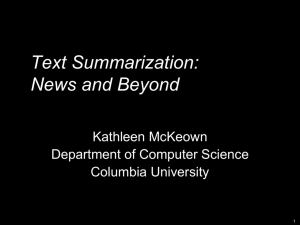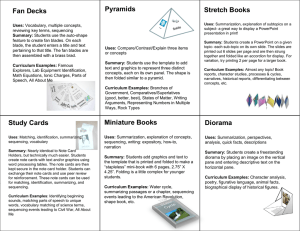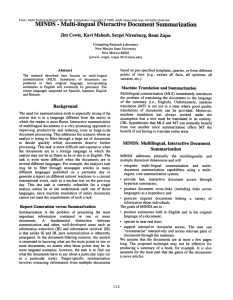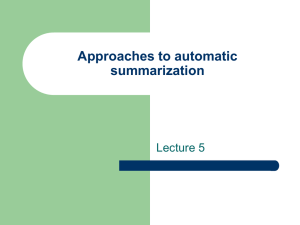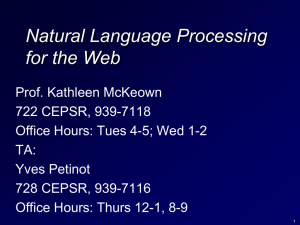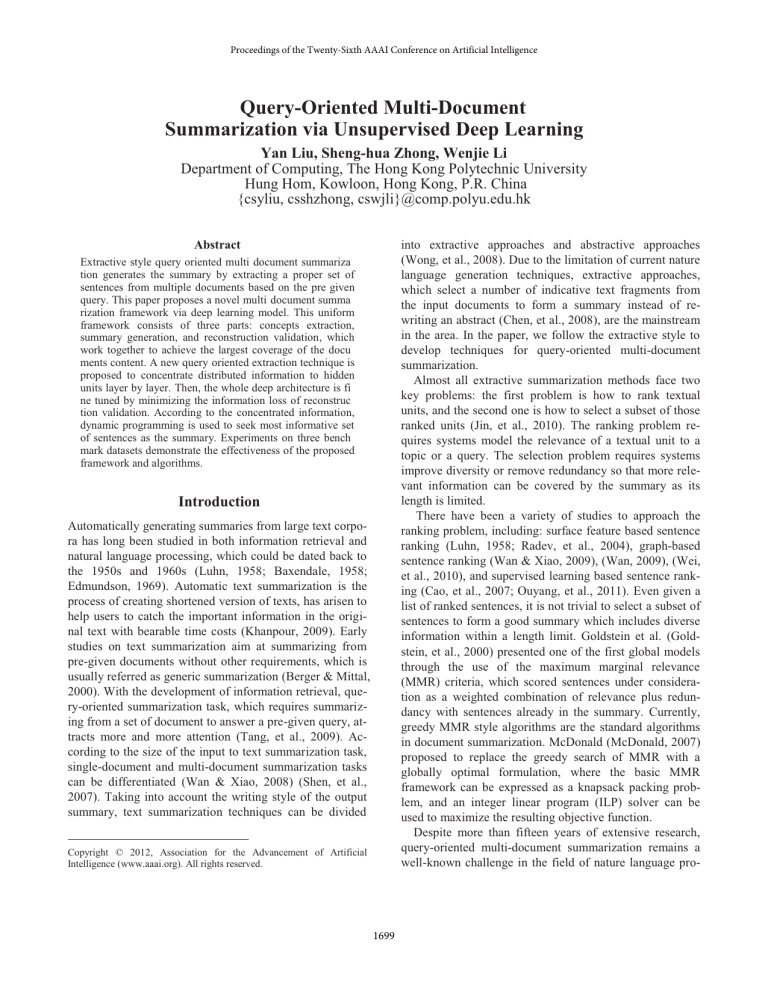
Proceedings of the Twenty-Sixth AAAI Conference on Artificial Intelligence
Query-Oriented Multi-Document
Summarization via Unsupervised Deep Learning
Yan Liu, Sheng-hua Zhong, Wenjie Li
Department of Computing, The Hong Kong Polytechnic University
Hung Hom, Kowloon, Hong Kong, P.R. China
{csyliu, csshzhong, cswjli}@comp.polyu.edu.hk
into extractive approaches and abstractive approaches
(Wong, et al., 2008). Due to the limitation of current nature
language generation techniques, extractive approaches,
which select a number of indicative text fragments from
the input documents to form a summary instead of rewriting an abstract (Chen, et al., 2008), are the mainstream
in the area. In the paper, we follow the extractive style to
develop techniques for query-oriented multi-document
summarization.
Almost all extractive summarization methods face two
key problems: the first problem is how to rank textual
units, and the second one is how to select a subset of those
ranked units (Jin, et al., 2010). The ranking problem requires systems model the relevance of a textual unit to a
topic or a query. The selection problem requires systems
improve diversity or remove redundancy so that more relevant information can be covered by the summary as its
length is limited.
There have been a variety of studies to approach the
ranking problem, including: surface feature based sentence
ranking (Luhn, 1958; Radev, et al., 2004), graph-based
sentence ranking (Wan & Xiao, 2009), (Wan, 2009), (Wei,
et al., 2010), and supervised learning based sentence ranking (Cao, et al., 2007; Ouyang, et al., 2011). Even given a
list of ranked sentences, it is not trivial to select a subset of
sentences to form a good summary which includes diverse
information within a length limit. Goldstein et al. (Goldstein, et al., 2000) presented one of the first global models
through the use of the maximum marginal relevance
(MMR) criteria, which scored sentences under consideration as a weighted combination of relevance plus redundancy with sentences already in the summary. Currently,
greedy MMR style algorithms are the standard algorithms
in document summarization. McDonald (McDonald, 2007)
proposed to replace the greedy search of MMR with a
globally optimal formulation, where the basic MMR
framework can be expressed as a knapsack packing problem, and an integer linear program (ILP) solver can be
used to maximize the resulting objective function.
Despite more than fifteen years of extensive research,
query-oriented multi-document summarization remains a
well-known challenge in the field of nature language pro-
Abstract
Extractive style query oriented multi document summariza
tion generates the summary by extracting a proper set of
sentences from multiple documents based on the pre given
query. This paper proposes a novel multi document summa
rization framework via deep learning model. This uniform
framework consists of three parts: concepts extraction,
summary generation, and reconstruction validation, which
work together to achieve the largest coverage of the docu
ments content. A new query oriented extraction technique is
proposed to concentrate distributed information to hidden
units layer by layer. Then, the whole deep architecture is fi
ne tuned by minimizing the information loss of reconstruc
tion validation. According to the concentrated information,
dynamic programming is used to seek most informative set
of sentences as the summary. Experiments on three bench
mark datasets demonstrate the effectiveness of the proposed
framework and algorithms.
Introduction
Automatically generating summaries from large text corpora has long been studied in both information retrieval and
natural language processing, which could be dated back to
the 1950s and 1960s (Luhn, 1958; Baxendale, 1958;
Edmundson, 1969). Automatic text summarization is the
process of creating shortened version of texts, has arisen to
help users to catch the important information in the original text with bearable time costs (Khanpour, 2009). Early
studies on text summarization aim at summarizing from
pre-given documents without other requirements, which is
usually referred as generic summarization (Berger & Mittal,
2000). With the development of information retrieval, query-oriented summarization task, which requires summarizing from a set of document to answer a pre-given query, attracts more and more attention (Tang, et al., 2009). According to the size of the input to text summarization task,
single-document and multi-document summarization tasks
can be differentiated (Wan & Xiao, 2008) (Shen, et al.,
2007). Taking into account the writing style of the output
summary, text summarization techniques can be divided
Copyright © 2012, Association for the Advancement of Artificial
Intelligence (www.aaai.org). All rights reserved.
1699
cessing because it is very difficult to bridge the gap between the semantic meanings of the documents and the
basic textual units. So this paper intends to propose a novel
framework by referencing the architecture of the human
neocortex and the procedure of intelligent perception via
deep learning. Different from shallow learning models
such as support vector machine (SVM), deep learning, like
deep belief network (DBN), models the learning task using
deep architectures composed of multiple layers of parameterized nonlinear modules. To our knowledge, this is the
first paper that utilizes deep learning in query-oriented
multi-document summarization task.
In the following parts of this paper, we first discuss the
motivation of utilizing deep learning to text summarization
task. Then, a novel deep architecture with three parts of
query-oriented concepts extraction, reconstruction validation for global adjustment, and summary generation via
dynamic programming are introduced. In the experiment
part, we demonstrate the performance of the proposed
framework and the new algorithms on three benchmark datasets. The paper is closed with conclusion.
because of the nonlinear structure of multiple hidden layers,
deep models can represent hard problem in more concise
way, which is well adapted the essentials of summarization
that includes information as much as it can with bearable
length. Second, because of the pair-wise hidden layers reconstruction learning in most deep models, distributed information can be concentrated gradually layer by layer
even if under unsupervised situation. This character will
benefit the learning in large dataset, just like multidocument summarization.
Although deep learning has never be used in document
summarization, many empirical validations have demonstrated that deep models have notable ability of multimedia
data abstraction (Taylor, et al., 2010) (Liu, et al., 2009) in
various tasks, such as image classification (Zhong, et al.,
2011), image generation (Dahl, et al., 2010), and audio
event classification (Ballan, et al. 2009). Hence, deep models are also promising to abstract text data effectively for
query-oriented multi-documents summarization.
Deep Architecture
This paper intends to provide a uniform framework of generating text summary automatically from the original multiple documents according to the query. As mentioned, this
is the first paper of utilizing deep learning in document
summarization. To adapt the characters of this new application, a novel unsupervised deep learning model Queryoriented Deep Extraction (QODE) with the new deep architecture is shown in Figure 1.
The feature vector f d [ f1d , f2d , , fvd , , fVd ] , the tf value
of word in the vocabulary of D calculated in document d m ,
is input into deep architecture. V is the length of the vocabulary of D . The output is a summary S [s1, s2 , , st , , sT ] .
For the hidden layer, Restricted Boltzmann Machines
(RBMs) are used as building blocks (Smolensky, 1986).
RBM is a two-layer recurrent neural network in which stochastic binary inputs and outputs are connected using
symmetrically weighted connections. RBMs are utilized as
the building blocks of deep models because the bottom-up
connections can be used to infer the more compact highlevel representations from low-level features and the topdown connections can be used to validate the effectiveness
of the generated compact representations. The parameter
space of the deep architecture is initialized randomly except for the input layer. The initial parameters of the first
RBM are also determined by the query words.
Based on the new deep architecture, the deep learning
procedure can be partitioned into three stages: concept extraction, reconstruction validation, and summary generation. In the concept extraction stage, three hidden layers
H 1 , H 2 , and H 3 are used to abstract the documents using
greedy layer-wise extraction algorithm. In our implementation, H 1 is used to filter out the words appearing accidental-
Deep Learning for Query-oriented Multidocuments Summarization
The rationale of utilizing deep learning in query-oriented
multi-documents summarization is to provide human-like
judgment by referencing human’s neocortex and the procedure of intelligent perception. Deep architecture is identical to the multi-layer physical structure of the human cerebral cortex. The neocortex, which is associated with many
cognitive abilities, has a complex multi-layer hierarchy
(Lee & Mumford, 2003). All functional areas of neocortex
can be roughly differentiated into six functionally distinct
horizontal layers (Leuba & Kraftsik, 1994). When it is taken into consideration that many different neocortex areas,
such as Broca’s and Wernicke’s areas, and other lexicalsemantic processing areas, are involved in lexical-semantic
processing, dozens of cortical layers are involved in generating even the simplest lexical-semantic processing. Therefore, deep learning model shows potentials to provide human-like judgment using a human-like system in tasks of
nature language processing.
Besides the evidences from neuroscience, some theoretical analyses from machine learning also provide support
for the argument that deep models are more compact and
expressive than shallow models in representing learning
functions, especially highly variable ones. Obviously, query-oriented multi-documents summarization is a highly intelligent task, even not easy for human beings. The mapping between the semantic meaning of multiple documents
and the basic textual units is not straightforward. Fortunately, deep learning has two attractive characters. First,
1700
ly. Hidden layer H 2 is supposed to discover the key words;
reconstruction validation part intends to reconstruct the data distribution by fine-tuning the whole deep architecture
globally. Finally, the dynamic programming (DP) is utilized to maximize the importance of the summary with the
length constraint. After these three stages, the final optimized summary S is generated. In the following session,
we will discuss the detailed learning procedure of each part.
where T1
between visible unit i in H 0 and hidden unit j in H 1 . bi1 is
the ith bias of layer H 0 and c1j is the jth bias of layer H 1 .
The first RBM has the following joint distribution:
P h0 , h1;T 1
e
E h0 , h1;T 1
log P h0
h0
1 T
h1
2T
(A )
p h1 | h0
h2
0
1
p h |h
(A3)T
log
p h |h
p h |h
1
j
j
0
h3
Candidate Sentence Extraction
h2
e
E h0 , h1;T 1
)
2
¦
h1
e
E h0 , h1;T 1
log
¦ ¦
h0
h1
e
E h0 , h1;T 1
3
0
i
i
1
p
,
¦ A h a )
V (¦ A h b )
V(
1| h0
hi0
1
1| h
0
ij i
j
j
1
ij j
j
4
i
5
1
(6)
0
h0
1
The idea of Contrastive Divergence (Hinton, 2002) algorithm use the difference between two Kullback-Leibler divergences is to take k small (typically k 1 ) to run the
claim for only one step. When k 1 , the derivative to the
model parameter A1 can be obtained by Equation (7),
Preprocessing
Word List
Document Topic Set
Query Oriented Initial Weight Setting
w log P(h1 (0))
h1 (0)T h0 (0) !data h1 (1)T h0 (1) !recon
wA1
Query Oriented Penalty Process
Query Word List
(7)
where data denotes an expectation with respect to the data
Figure 1: Deep architecture of QODE technique
distribution and recon denotes the “reconstruction” distribution of data after one step. This leads to a simple learning
rule for performing stochastic steepest ascent in the log
probability of the training data in Equation (8).
Query-oriented Concept Extraction
First, we generate a vocabulary with length V based on the
words appearing in the document topic set D . The feature
vectors f D [ f1D , f2D , , fvD , , fVD ] of the document set D
and f d [ f1d , f2d , , fvd , , fVd ] of the single document d m are
calculated. Here, fvD is the tf value of vth word in the vocabulary of D calculated in all documents. f vd is the tf value of vth word in the vocabulary of D calculated in d m .
A1 - A1 A1 - A1 H A ( h1 (0)T h0 (0) !data h1 (1)T h0 (1) !recon )
8
Other parameters in T update function could be calculated
in a similar manner, where - is the momentum and
H A , H b , H c are the learning rate.
1
b1 -b1 b1 -b1 H b (h0 (0) h0 (1))
1
c
d
Then, f is input to the deep architecture as the visible
layer H 0 to construct a RBM with hidden layer H 1 . The energy of the state ( h0 , h1 ) in the first RBM is:
((h 0 )T A1h1 (b1 )T h 0 (c1 )T h1 )
h1
wE (h1 (0), h0 (0))
wE (h1 (k ), h0 (k ))
¦ h0 (0) p(h (0) | h (0))
¦ h1 ( k ) ¦ h0 ( k ) p(h1 (k ), h0 (k ))
wT 1
wT 1
Not Important Words
Filtering Out
E h 0 , h1 ;T 1
h0
w log p(h1 (0))
wT 1
h1
fd [f1d, f2d, , fvd, , fVd] tf Value
¦ ¦
low:
Key Words Discovery
A1
)/(
Denote h (k ) for the k-th h sample from the chain, starting
at k 0 with h1 (0) , which is the input observation for the
of is a sample from the
RBM and (h1 (k ), h0 (k )) for k
Markov chain. So we could calculate the derivative of
Equation (3) with respect to the parameter T 1 A1, b1, c1 be-
Concept Extraction
A2
E h0 , h1;T 1
, p h1j
1
A3
(e
Gibbs sampling from an RBM proceeds by sampling h1
given h0 , then h0 given h1 , etc. The conditional distributions over input state h0 in visible layer H 0 and hidden state
h1 in hidden layer H 1 are given by Equation (4) and (5),
where V ( x) 1/ (1 exp( x)) .
Reconstruction Validation
(A )
/Z
where Z is the normalization constant. The log-likelihood
probability of assigning to a visible vector to h0 in H 0 is:
Summary
Candidate Sentence Pool
are the model parameters between lay-
er H 0 and layer H 1 . Aij1 is the symmetric interaction term
Summary Generation
Dynamic Programming
A1, b1, c1
-c c
1
1
-c H c (h (0) h (1))
1
1
1
9
10
To integrate query information for document summarization, we have two different processes including: query
oriented initial weight setting and query oriented penalty
process. In classical deep network, the parameter matrix A1
(1)
1701
is initialized to small random values chosen from a zeromean Gaussian with a standard deviation of about 0.01.
Different from it, we strengthen the influence from query
as Equation (11) after random initialization setting if the ith
node word vi in H 0 belongs to the query.
Aij1 max( A1 ) if vi q
Summary Generation via Dynamic Programming
In this stage, DP is utilized to maximize the importance of
the summary with the length constraint.
After the optimum parameters are obtained in the reconstruction validation, we use them to calculate the importance matrix AF by Equation (13). Then we extract ten
words with largest AFin value in every nth node of hidden
layer H 3 . The set of these unions words are denoted as
UN . The importance of every sentence In t is calculated
by Equation (14), where O is the query word importance
factor, P i is the word in sentence st . And the importance
of the generated summary could be denoted as In =¦ t In t .
11
In the penalty process, the reconstruction error in query
word is penalized more than others as below, where J is
the penalty factor.
Aij1 =J
1
ij
if
i q
12
The above discussion is based on single document d m for
the first layer. Similar operations can be performed to the
higher layer RBMs based on all documents in topic set D .
After the concept extraction based on the deep architectures, the importance matrix AF is defined as Equation (13).
The element AFin of AF is the importance of ith word in the
vocabulary to the nth node of hidden layer H 3 , where K 3 is
In t
In our implementation, hidden layer H is assumed to
extract the candidate sentences for the summary. Certainly,
we could extract the candidate sentences of every node in
H 3 only depend on how many unions of key words are in
them according to AFin . In our technique, after the reconstruction validation part globally adjust the deep network
to find optimum parameters, the DP is utilized to maximize
the query oriented importance of generated summary with
the constraint of summary length.
max In =
others
(15)
¦ In ,
t
t
s.t. Le d NS
(16)
In context of mathematical optimization method, DP refers
to simplifying a complicated problem by breaking it down
into simpler sub-problems in a recursive manner. The optimization problem in (16) is classical knapsack problem
which is often solved by DP. So we use DP to find the optimum solution.
The DP function is denoted in Equation (17). Here,
f K (OK ) is the maximum of the summary importance in stage
K . K is the stage variable to describe the current sentence.
The state variable OK is the remaining length before
K starts. The decision variable uK is the choice whether or
Reconstruction Validation for Global Adjustment
In the first part, we use greedy layer-by-layer algorithm to
learn a deep model for concept extraction. In this part, we
use backpropagation through the whole deep model to finetune the parameters T [ A, b, c] for optimal reconstruction.
The greedy layer-by-layer query-oriented concept extraction stage has performed a global search for a sensible
and good region in the whole parameter space. Therefore,
after the first part, we already construct a good data concept extraction model. Backpropagation is well known as a
better local fine-tuning model than global search. So
backpropagation is utilized to adjust the entire deep network to find good local optimum parameters T * [ A* , b* , c* ]
which is used in summary generation via DP. And the
learning algorithm in this stage is used to minimize the
not to put the current sentence st into the summary.
­ f K (OK ) max{uK In K f K 1 (OK 1 )}
°
K t ,1 d t d T
® OK OK 1 uK 1lK 1 ,
°O 0, O 250, f (O ) 0
T
0 0
¯ 0
(17)
After solving the Equation (17) by positive sequence
method,
we
obtain
the
optimized
summary
S {s1 , s2 ,...., st ,..., sT } , where st is the optimized sentence.
cross-entropy error [¦ v fv log fv ¦ v (1 fv )log(1 fv )] , where f v
is the tf value of v
struction.
(14)
Based on the analysis above, we obtain the objective function aims to optimize with the constraint below. Because
the task of Document Understanding Conference is to produce query-oriented multi-document summarization with
allowance of 250 words, in our paper, NS is equal to 250.
3
th
if Pi UN
Le l1 ... lt ... lT d NS
(13)
K3
if ( Pi UN) ( Pi q)
Taken the limited length of summary NS into consideration, the summary length Le is defined as below, where
lt is the length of sentence st .
the number of unit in H 3 , A1, A2 , A3 are the symmetric interaction term in layer pairs.
AF [((f D )T , (f D )T , , (f D )T , , f D )T ]( 1 A2 A3 )
¦
­Zi O
°
Zi , ® Zi 1
i
°Z 0
¯ i
Empirical Validation
word and f v is the tf value of its recon-
Evaluation Setup
In this section, we conduct several experiments for multidocument summarization task evaluation in the Document
1702
Table 2. Query Oriented Contribution Analysis
Method
ROUGE-1
ROUGE-2
ROUGE-SU4
1
2
3
0.3751
0.0775
0.1341
√
√
√
0.3731
0.0742
0.1315
√
√
0.3734
0.0755
0.1329
√
√
0.3704
0.0740
0.1301
√
√
1. Query oriented initial weight setting, 2. Query oriented penalty process,
3. Summary importance maximization by DP
Understanding Conference (DUC) on three open benchmark dataset DUC 2005, DUC 2006 and DUC 2007. There
are altogether 50 topics, 50 topics, and 45 topics in DUC
2005, DUC 2006 and DUC 2007, respectively.
The task of DUC is to produce query-oriented multidocument summarization with generous allowance of 250
words. As a preprocessing step, the stop words in each sentence are removed and the remaining words are stemmed
using the Porter’s stemmer (Porter, 1980). In the evaluation
step, the ROUGE (Lin, 2004) toolkit (i.e. ROUGEeval1.5.5 in this study) is used for evaluation, which has been
widely adopted by DUC tasks.
In performance comparison of three open datasets, we
provide the results of the average recall scores of ROUGE1, ROUGE-2 and ROUGE-SU4. We compare the performance of QODE with other representative multi-document
summarization algorithms, including graph-based sentence
ranking algorithms such as: Manifold-ranking model (Wan
& Xiao, 2009), Multiple-modality model (Wan, 2009), and
Document-sensitive model (Wei, et al., 2010); supervised
learning based sentence ranking algorithms: SVM Classification (Vapnik, 1995), Ranking SVM (Jochims, et al.,
2002) , Regression (Ouyang, et al., 2011); classical relevance and redundancy based selection algorithms: greedy
search (Filatova & Hatzivassiloglou, 2004), maximum
marginal relevance (MMR) (Goldstein, et al., 2000), integer linear program (ILP) (McDonald, 2007); and the NIST
baseline system (Dang, 2005).
In Table 3 and 4, we also provide the performance comparison on DUC 2006 and DUC 2007. As an unsupervised
learning algorithm, the performance of QODE is similar to
the supervised learning based regression algorithm
(Joachims, 2002). Therefore, we can still conclude that our
system is able to achieve state-of-the-art performances giving the sufficient results listed above.
Table 3. Comparison to representative algorithms on the DUC 2006
System
ROUGE-1
ROUGE-2
ROUGE-SU4
0.4015
0.1479
QODE
0.0928*
0.0886
0.1420
Manifold-ranking
0.4101*
0.4031
0.0851
0.1400
Multiple-modality
0.0899
0.1427
Document-sensitive
0.0834
0.1387
SVM Classification
0.0890
0.1443
Ranking SVM
0.0926
Regression
0.1485*
0.0491
0.0962
NIST Baseline
Table 4. Comparison to representative algorithms on the DUC 2007
System
ROUGE-1
ROUGE-2
ROUGE-SU4
0.4295
0.1163
QODE
0.1685*
0.4204
0.1030
0.1460
Manifold-ranking
0.1123
0.1682
Multiple-modality
0.4211
0.1103
0.1628
Document-sensitive
0.1075
0.1616
SVM Classification
0.1682
Ranking SVM
0.4301*
0.1175*
0.3091
0.0599
0.1036
NIST Baseline
Performance Comparison
Firstly, we compare the performance of the proposed techniques with other representative ones on three standard datasets based on ROUGE scores. From the results of DUC
2005 shown in Table 1, it is obvious that our algorithm
outperforms most of existing algorithms.
Parameter Tuning
There are numerical meta-parameters in the proposed techniques. For the parameters related with deep model, such
as learning rate and the momentum, we simply follow the
general setting (Hinton, 2010), although more careful
choice may lead to better performance. The structure of
deep learning model is another set of parameters, different
with existing deep learning techniques that determine the
structure such as the number of hidden layers based on intuition. We intend to provide more meaningful architecture
by considering the characters of document summary task.
In our implementation, the hidden layer H 1 is used to filter
out the words appearing accidentally and 1000 hidden units
are used in this paper. Hidden layer H 2 is supposed to discover the key words; therefore, the number of hidden units
depends on the length of summary. In our experiment, the
length is predetermined by the DUC tasks with allowance
of 250 words, so we use 250 hidden units in H 2 . Hidden
layer H 3 is assumed to extract the candidate sentences for
the summary. If the length of the summary is equal to 250
words, 10-hidden-unit is a reasonable setting of H 3 .
Table 1. Comparison to representative algorithms on the DUC 2005
System
ROUGE-1
ROUGE-2
ROUGE-SU4
0 3751
QODE
0.0775*
0.1341*
*
0.0737
0.1317
Manifold-ranking
0.3839
0 3718
0.0676
0.1293
Multiple-modality
0.0771
0.1337
Document-sensitive
0 3663
0.0701
0.1243
SVM Classification
0 3702
0.0711
0.1299
Ranking SVM
0 3770
0.0761
0.1329
Regression
0 3560
0.0610
Greedy search
0 3701
0.0701
0.1289
MMR
0 3580
0.0610
ILP
0.0403
0.0872
NIST Baseline
In proposed QODE, we integrate query information in
concept extraction, layer-wise reconstruction, and summary generation. Table 2 shows the query oriented contribution analysis in three stages. Obviously, each step has its
own contribution to the final summary generation.
1703
In layer H 2 , the number of hidden layer is reduced to
250. As previously, we calculate how many words pushed
out by H 2 with higher extraction weights appear in human’s summary in Table 6. The words of human summary
coverage percentage is about 40%, which is nearly doubled
to layer H 1 . For the convenience of comparison, we randomly select 250 words from 2032 and calculate that how
many of them appear in the human’s summary. We repeat
the experiments ten times and calculate the average percentage. Comparing these two results, the proposed techniques demonstrate the extraction ability again.
For the parameter used in dynamic programming, we
discuss the influence to ROUGE result on DUC 2005 from
query word importance O . Figure 2(a) shows the value of
ROUGE-2 and Figure 2 (b) shows the value of ROUGESU4 when O varies from 1 to 3. At most time, the proposed technique has the best performance. ROUGE-2 and
ROUGE-SU4 peak together when O is equal to 2.4. Similar to DUC 2005, the peak points of ROUGE-2 and
ROUGE-SU4 curve can be obtained when O is equal to
2.4 on DUC 2006 and DUC 2007.
Table 6. The statistical analysis of words in layer H 2
Words
Number
In Human Summary
Percentage
Random words
250
34
13.6%
Key words
250
99
39.6%
There are ten hidden units in layer H 3 that corresponds
to the ten sentences appearing in the 250-words summary.
In Table 7, we list ten candidate sentences related with corresponding nodes. To compare with human summary, the
ID numbers of human summary which has similar sentence
are also listed. Therefore, inheriting the distinguished extraction ability from deep learning model, proposed QODE
pushes out important concepts layer by layer effectively.
(a) ROUGE 2 Recall performance vs. O
Table 7: Candidate sentence extracted in layer H 3
Sentence with Union of Key Words in Automatically
Id of Human’s
Extracted Summary
Summary
An international war crimes tribunal covering the forA,B,C,D,E,G,H,I
mer Yugoslavia formally opens in The Hague today with
,J
a request for the extradiction from Germany of a Bosnian
Serb alleged to have killed three Moslem prisoners.
The extradiction is important to the tribunal - the first in- B,C,D,E,G,H,I,J
ternational war crimes court since the Nuremberg trials
after the second world war - because it has no power to
try suspects in absentia.
World News in Brief: Court rules on border.
A,C,D,E,G,H,I,J
The International Court of Justice in The Hague ruled in
B,D,E,H,I,J
Chad's favour in a 20-year border dispute with Libya
which has caused two wars.
Maybe we'll go full circle; the World Court can condemn
C,D,G,I,J
this action and then the Soviets can defy that body, just as
the United States defied the court's condemnation of our
embargo of Nicaragua.
Ever since the Reagan Administration walked out of the
H,I,J
Hague to protest Nicaragua's claim of illegality in U.S. aid
to the Contras, the State Department has opposed submitting to the World Court any case that involves the use of
military force.
They refused to appear in the World Court 10 years ago
H,I,J
when Washington sought the release of American hostages
in Tehran.
A year after Noriega's capture, the court was still hearing
J
arguments on whether Bush could be subpoenaed and the
World Court was in preliminary hearings on Panama's
complaint.
After six months of uproar, the U.S. district court judge in
Null
Miami ordered that the case proceed to trial.
Mr Edwin Williamson, a legal adviser to the U.S. State
Null
Department who will address the court later in the proceedings, said yesterday, ‘This (court) action in no way
inhibits what the Security Council is doing. ’
(b) ROUGE SU4 Recall performance vs. O
Figure 2: Performance comparison vs. O .
Physical Information in Deep Network Analysis
Furthermore, we want to demonstrate the rationale of the
proposed techniques, whether QODE really has advanced
extraction ability. To demonstrate the extraction ability of
proposed QODE, we analyze the information coverage in
every layer using one document set D376e. In the document set D376e. There are 26 documents in this set and 9
human summaries are provided. For dataset D376e, the
number of nodes in layer H 0 is equal to 2032. In our experiment, we set the number of hidden nodes in layer H 1 to
1000. So we keep 1000 words pushed out by H 1 with higher extraction weights and calculate how many of them appear in human’s summary. We also calculate the percentage according to the filtering out 1032 words. From Table
5, obviously, deep networks intend to find the informative
words.
Table 5. The statistical analysis of words in layer H 1
Words
Numbers
Filtering out words 1032
Remaining words
1000
In Human Summary
65
211
Percentage
6.3%
21.2%
1704
Joachims, T. (2002). Optimizing search engines using click
through data. In Proc. of KDD.
Jin, F., Huang, M.L., and Zhu, X.Y. (2010). A Comparative
Study on Ranking and Selection Strategies for Multi Document
Summarization. In Proc. of COLING.
Lee, T., Mumford, D. (2003). Hierarchical Bayesian inference in
the visual cortex”, In JOSAA.
Leuba, G., Kraftsik, R. (1994). Changes in volume, surface esti
mate, 3 dimensional shape and total number of neurons of the
human primary visual cortex from midgestation until old age. In
Inat. Embryol..
Larochelle, H.; Erhan, D.; Courville, A.; Bergstra, J.; and Bengio,
Y. (2007). An Empirical Evaluation of Deep Architectures on
Problems with Many Factors of Variation, In Proc.of ICML.
Lin, C.Y. (2004). Rouge: A package for automatic evaluation of
summaries. In Proc. ACL.
Liu, Y.; Xu, D.; Tsang, I. W.; Luo, J. (2009). Using Large Scale
Web Data to Facilitate Textual Query Based Retrieval of Con
sumer Photos. In Proc.of ACMMM.
Luhn, H. P. (1958). The automatic creation of literature abstracts.
IBM Journal of Research Development.
Khanpour, H. (2009). Sentence Extraction for Summarization
and Notetaking. PhD. Diss.. University of Malaya.
McDonald, R. (2007). A study of global inference algorithms in
multi document summarization. Lecture Notes in Computer Sci
ence.
Ouyang, Y. Li, W.J., Li, S.J., Lu, Q. (2011). Applying regression
models to query focused multi document summarization. Infor
mation Processing and Management.
Radev, D. R., Jing, H.Y., Stys, M., and Tam, D. (2004). Centroid
based Summarization of Multiple Documents. Information
Processing and Management.
Shen, D., Sun, J.T., Li, H., Yang, Q., and Chen, Z. (2007).
Document Summarization using Conditional Random Fields. In
Proc. of. IJCAI.
Smolensky, P. 1986. Information Processing in Dynamical Sys
tems: Foundations of Harmony Theory. Parallel Distributed Pro
cessing: Explorations in The Microstructure of Cognition.
Tang, J., Yao, L., and Chens, D. (2009). Multi topic based query
oriented summarization. In Proc. of SLAM International
Conference on Data Mining.
Taylor,G., Fergus, R., Cun, Y.L. and Bregler, C. 2010. Convolu
tional learning of spatio temporal features. In Proc. of. ECCV.
Wan, X., Xiao, J.. (2008). Single document keyphrase extraction
using neighborhood knowledge. In Proc. AAAI.
Wan, X. & Xiao, J.. (2009). Graph Based Multi Modality Learn
ing for Topic Focused Multi Document Summarization. In Proc.
of IJCAI.
Wan, X.. (2009). Topic Analysis for Topic Focused Multi
Document Summarization. In Proc. of CIKM.
Vapnik, V. N. (1995). The nature of statistical learning theory.
Springer.
Wei. F., W.J. Li, Q. Lu, and Y.X. He, (2010). A document
sensitive graph model for multi document summarization.
Knowledge and Information Systems.
Wong, K.F., Wu, M.J., and Li, W.J. (2008). Extractive
Summarization Using Supervised and Semi supervised Learning.
In Proc. of. ICCL.
Zhong, S.H., Liu, Y., Liu, Y.. 2011. Bilinear deep learning for
image classification. In Prof. of ACMMM.
Conclusion
This paper proposes a novel deep learning model for query-oriented multi-documents summarization. Inheriting the
distinguished extraction ability from deep learning, the
proposed framework pushes out important concepts layer
by layer effectively. According to the empirical validation
on three standard datasets, the results not only show the
distinguishing extraction ability of QODE but also clearly
demonstrate our intention of providing a human-like multidocument summarization for nature language processing.
Acknowledgments
This research was supported by HK PolyU 5183/11E.
References
Ballan, L.; Bazzica, A.; Bertini, M.; Bimbo, A. D. ; Serra, G.
(2009). Deep Networks for Audio Event Classification in Soccer
Videos. In Proc.of ICME.
Baxendale, P. B. (1958). Machine made index for technical
literature an experiment. IBM Journal of Research
Development.
Berger, A., and Mittal ,V. (2000). Query relevant summarization
using FAQs. In Proc. of ACL.
Cao, Z., Qin. T., Liu, T., Tsai, M., Li, H., (2007). Learning to
Rank: from Pairwise Approach to Listwise Approach. In Proc. of
ICML.
Clancey, W. J. (1979). Transfer of Rule Based Expertise through
a Tutorial Dialogue. Ph.D. diss., Department of Computer Sci
ence, Stanford University, Stanford, CA.
Cao, L.; Yu, J.; Luo, J. and Huang, T. S. (2009). Enhancing Se
mantic and Geographic Annotation of Web Images via Logistic
Canonical Correlation Regression. In Proc.of ACMMM.
Chen, E.K., Yang, X.K., Zha, H.Y., Zhang, R., and Zhang, W.J.
(2008). Learning Object Classes from Image Thumbnails through
Deep Neural Networks. In Proc. of ICASSP.
Dahl, G.; Ranzato, M.; Mohamed, A.; Hinton, G. E. (2010).
Genearting more realistic images using gated MRF’s. In Proc. of
NIPS.
Dang, H.T. (2005). Overview of DUC 2005. In Proc. of DUC
2005.
Edmundson, H. P. (1969). New methods in automatic extracting.
Journal of the ACM.
Filatova, E., and Hatzivassiloglou, V., (2004). A formal model for
information selection in multisentence text extraction. In Proc. of
COLING.
Porter, M.F. (1980). An algorithm for suffix stripping,” Program.
Goldstein, J., Mittal, V., Carbonell, J., and Kantrowitz, M..
(2000). Multi Document Summarization by Sentence Extraction.
In Proc. of the ANLP/NAACL Workshop on Automatic Summa
rization.
Hinton, G.E. (2002). Training products of experts by minimizing
contrastive divergence. Neural Computation.
Hinton, G. E.;Osindero, S.;The, Y. (2006). A Fast Learning Algo
rithm for Deep Belief Nets. Neural Computation.
Hinton, G.E. (2010). A practical guide to training restricted
Boltzmann machine. Tech. rep., 1 21, University of Toronto.
1705



